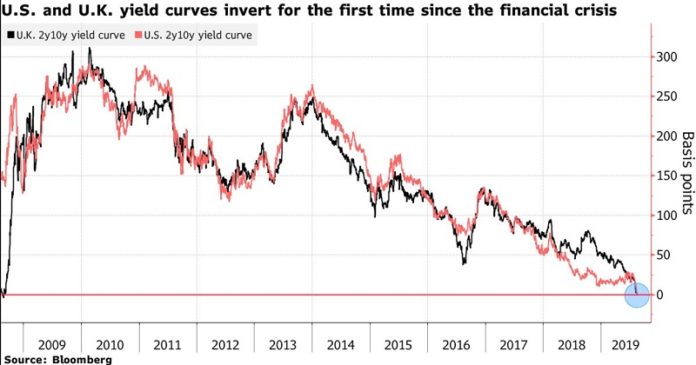For the second time in August, U.S. stocks experienced a sharp selloff this week. According to pundits, it was the fourth largest point decline in the history of the Dow Jones Industrial Average.
Yikes!
Except points are not percentages, and we will continue to see larger and larger point moves for the index as the market climbs to new highs. The 800-point drop Aug. 13 was a 3.05 percent decline. In comparison, the 679-point drop Dec. 1, 2008, during the “great recession” was a whopping 7.7 percent decline.
Investors are better off avoiding the temptation to succumb to Dow point sensationalism.
A 3 percent daily drop for stocks is still a significant move. The sell off earlier this month was likely in response to a temporary yield curve inversion — at least those pundits and economists think so.
This time the inversion was a “real” one. The yield on the 10-year Treasury note dropped 1 basis point below the yield on the two-year Treasury note.
Why is this important? The two-year and the 10-year are the sections of the yield curve that have inverted before each of the last nine economic recessions. Last week’s yield curve inversion was seen as a legitimate warning sign that the U.S. economy could be headed for recession.
The time frame when past inversions occurred and the start of recessions are random at best. Last week’s inversion did not hold, and today the 10-year note is yielding higher than the two-year note.
The U.S.-China trade negotiations have been looming large over the news cycle as well. After talks between the trade partners in Shanghai finished with little progress earlier this month, Trump declared $300 billion in new tariffs. China retaliated by halting purchases of U.S. agricultural products and devaluating the yuan.
The U.S. backed off soon after, announcing a delay in the $300 billion in new tariffs on electronics and consumer products made in China until mid-December. The pundits again said it appeared the threat of harming the Christmas shopping season took precedence over applying more pressure on the Chinese.
What happened next? And what happens every time we have wild swings in the stock markets? Out of the woodwork come the so-called experts — those pundits, enticing you to click online, or the financial media panic-coverage, screaming on TV. The stock market leads the nightly news and the one-hour radio call-in shows. The “noise” out there is enough to create jitters, panic or anxiety in the average investor.
So what is an investor to do?
Some investors may not like what I’m going to say, but sometimes the best medicine doesn’t taste good. If you have put together a financial plan, if your investment strategy aligns with that plan, then you should do nothing.
However, if all the “noise” out there makes you nervous and keeps you up at night, then turn off the noise, and talk to your financial advisor to make sure your investments align with your overall financial plan.
No one knows when the next bear market will start. It could be next week, next month or next year. But there will be another bear market. They are expected. For long-term investors, they are a requirement that allows that investor to earn a market return.
Trying to time the market yields two opportunities to be wrong: when to get out and when to get back in. Most market timers miss the opportunity to get back in, and that mistake costs them more than the decline they avoided. There are numerous studies showing the average investor making significantly less than that of market returns.
Reason why? They panic and sell when markets have gone down and wait too long to get back in and miss the recovery going up.
Investing is not easy. Our brains are not wired to save a bunch of money, watch it fluctuate wildly in value and then comprehend the impact of cost inflation 30 years in the future. When our portfolios hit new all-time highs, we are elated. Anything less than that is now a “loss” that causes pain and despair.
The daily swings of the stock market can cause a panic. You may have gotten a call from your sister, your cousin, your neighbor or even your adult kids this week, asking what you plan to do.
Market swings happen every year, some more volatile than others. According to American Funds, a market drop of 5 percent happens every 4.5 months, a 10 percent or more decline happens every 1.3 years on average and 15 percent or more every 3.5 years on average.
The best prescription? Take deep breaths, exhale, change the channel and relax.
If you would like more information regarding financial aid or college savings, Vince Sturm can be reached at his Perry office at 515-465-9843 or at vince@genwealthadvisors.com.


















[…] Posted By: Editor This article was originally published on this site […]